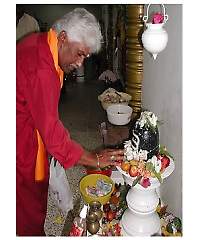 TRINIDAD AND TOBAGO – Just like Carnival, the festival of Shiva Raatri should be promoted as a significant event on the cultural and tourism calendar of Trinidad and Tobago. In addition to the regular Carnival attractions, tour operators should take tourists to Shiva Raatri celebrations to showcase the rich cultural diversity of the island.
TRINIDAD AND TOBAGO – Just like Carnival, the festival of Shiva Raatri should be promoted as a significant event on the cultural and tourism calendar of Trinidad and Tobago. In addition to the regular Carnival attractions, tour operators should take tourists to Shiva Raatri celebrations to showcase the rich cultural diversity of the island.
The sacred festival of Shiva Raatri often coincides with the secular celebration of Carnival in the twin-island republic. The dates for both events are calculated by the lunar calendar with Carnival climaxing at mid-night on Tuesday, and Shiva Raatri ending about the same time. This year, the Hindu festival of Shiva Raatri falls on the final day of Carnival, which was originally a Roman Catholic “last-hurrah” celebration bidding “farewell to the flesh.”
Carnival ends before Ash Wednesday which is dedicated to the confession of one’s sins. It is expected that many Catholics who participated in Carnival would go to mass to place ash on their forehead as a symbol of repentance. Ash Wednesday begins the fasting period known as Lent. It also marks the Seventh Wednesday before Easter which celebrates the resurrection of Jesus Christ.
While Hindus fast and pray in congregation during Shiva Raatri, Roman Catholics observe pious or penitential practices after Carnival. For Hindus who participate in Carnival, this year’s Carnival presents a challenge because they are free to indulge in the senses when Carnival is finished.
While Hindu devotees worship Lord Shiva for Shiva Raatri, as the Divine Dancer, Roman Catholics celebrate King Carnival as the Supreme Being of Bacchanal. It must be emphasized that both expiatory figures, as well as the ceremonies and imagery associated with them, are oppositional
Shiva Raatri means the Great Night of Lord Shiva. The festival is observed on the fourteenth lunar night of the dark, moonless fortnight in the Hindu month of Phalgun, which corresponds to late February or early March in the Western Gregorian calendar.
Lord Shiva is the divine Destroyer or Transformer among the Trinity of Hindu Gods. He is often depicted with a cobra coiled around his neck, symbolising the power he has over the deadliest of creatures. Lord Shiva is also portrayed with a crescent-shaped moon on the left side of his head. The moon represents the cycle of time through which creation evolves, from beginning to end.
Lord Shiva is usually worshipped in the form of an iconic lingam, a sacred oval pillar of stone, demonstrating that God exists in an abstract form. He is depicted as an omniscient yogi, immersed in deep meditation, who resides on Mount Kailash. Lord Shiva is also portrayed as the Cosmic Dancer who performs the divine dance, signifying the cosmic cycles of creation and destruction, as well as the etrnal rhythm of birth and death.
During Shiva Raatri, pooja [ceremonial worship] is performed in honour of Lord Shiva. Devotees abstain from eating and drinking during preparations for the pooja, which begins at sunset and ends at sunrise.
From nightfall to sunrise, devotees flock to temples in reverence to Lord Shiva. Women pray for the well-being of their family members, married women pray for matrimonial bliss and unmarried girls pray for a good husband. It is believed that the grace of Lord Shiva is at its maximum on this auspicious night. Devotees offer li
bations by bathing the lingam with jal [water], milk, honey, dahee [curd], ghee [clarified butter] and sugar-cane juice. Other offerings to the lingam include wood apple or bael leaves [Aeglemarmelos] and fruits and flowers. Offerings are also made to other deities in the temple, as well as to the pundit [Hindu priest], who directs the proceedings.
A vigil is maintained all night during which bhajans and kirtans [hymns and praises] are sung to the accompaniment of music. The temple reverberates with the sounds of gongs, bells, horns and chants of “Om Namah Shivaya,” meaning “Praise the name of Lord Shiva.” Devotees circumambulate the lingam and make their offerings to it. After this, their fast could be broken. Hindus who participate in Carnival are then free to party and masquerade.





